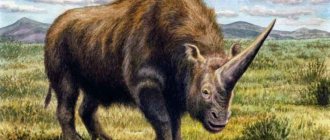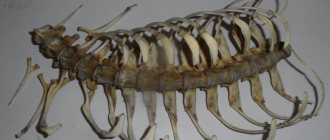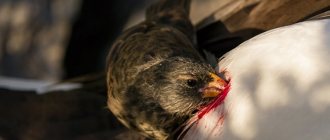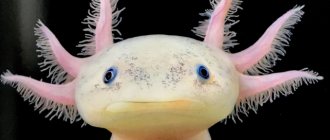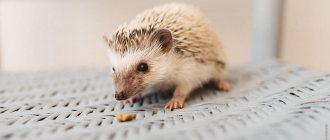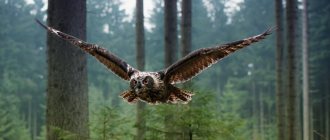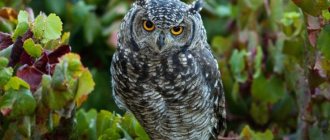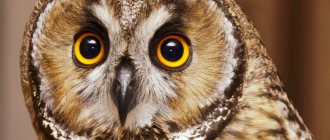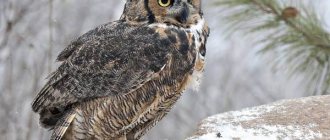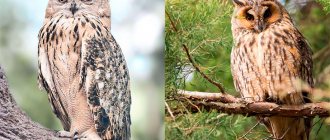Long eared owl
This bird grows up to 40 cm and is not the largest owl in the world. Although the size of the bird is relatively small, its wingspan reaches 90 cm. But it boasts the largest feathered ears on its head.
The bird's habitat stretches from the Far East to the Pyrenees. And the eared predator, which lives in the Western Hemisphere, is found in Central America. It is one of the most common representatives of the genus and can live both in caves and in the vicinity of people.
Etymology and history of research
John Gould named the owl by this name Athena? strict
.
That the specimen type for the description came from New South Wales.[4] Led 1837 by Brian Houghton Hodgson, a new genus Ninox
for
Ninox nipalensis
a, which is now synonymous with the subspecies Falcon Owl (
Ninox scutulata lugubris
) (Tickell, 1833).[5] The giant owl was later added to this genus. It consists of "Nisos, Νῖσος" for "falcon" and the Latin "noctua" "for" owl, consecrated in honor of the Roman goddess. Minerva" together. In Greek mythology, Nisus, the king of Megara, turned into a hawk.[6] That the specific epithet "Strenua" comes from the Latin "restless, lively".[7]
Hawk owl
This large owl grows up to 45 cm and has a very long tail. The large bird is easily recognized by the unusual color of its plumage, which combines an absolutely white underside with a chocolate-brown top with white speckles. Like all representatives of the genus, the feathered predator has a sharp beak and tenacious claws.
The large bird lives in American, European and Asian forests. In Russia, it is found only off the coast of the Sea of Okhotsk. The large bird of prey feeds on squirrels and small rodents, and sometimes attacks small birds.
Interesting! The image of a hawk owl is actively used in philately. And its name was given to an asteroid discovered in 1911.
WHAT DOES IT EAT?
The eagle owl's menu is the most varied among all birds of prey. And this is thanks not so much to the size and strength of the bird, which easily defeats large prey, but to its ability to adapt. Having the opportunity to take advantage of a new food source, the eagle owl easily changes its hunting habits. Researchers estimate that throughout its range, the eagle owl preys on 110 species of mammals and 140 species of birds. Even such large birds as pheasant, falcon and raven become victims of the eagle owl. Occasionally, for variety, its diet is replenished with frogs, snakes, fish, crustaceans, insects and spiders. The eagle owl's hunting grounds are mainly open spaces, but it can also pursue prey in dense forests. In most cases, the eagle owl looks out for prey, sitting in a convenient place, a kind of observation post. Not a single rustle or movement escapes his attention, since the bird has perfectly developed vision and hearing. The eagle owl makes reconnaissance flights from time to time in search of colonies of birds nesting on rocks, trees or swamps. These large owls are capable of defeating prey as large as themselves.
desert eagle owl
This large predator grows up to 50 cm and has an alternative name - pharaoh owl. It is easily recognized by the large feathery ears on its head and the black rim around its facial disc.
The large desert eagle owl is found in the Middle East and North Africa. It forms a monogamous pair, is nocturnal and feeds on small rodents.
Interesting! The scientific name of the desert eagle owl is Bubo ascalaphus, given in honor of one of the demons from ancient Greek myths.
The pioneering Apple Macintosh computer
1984 Apple Macintosh commercial video (HD)
Advertising has enormous power. The power to influence huge numbers of people. Push the idea. Make it seem like you just need to buy the product. This was the case in the era of print advertising. When the time came for television, advertising took the form of video clips.
Some of them went down in history, perhaps because of their ingenuity or the fact that they were promoted. As was the case with the first personal computer, the spread of which marked the beginning of a revolution in computing. We remembered this in the section “What happened on this day”, which is prepared by Eng. Frantisek Houdek.
Great Gray Owl
This is one of the largest owls in the world. The large bird of prey weighs 0.6-1 kg and grows up to 80 cm, and its wingspan reaches 1.5 m. It has an elegant white collar and a black spot under the beak, which is how it got its name.
The great gray owl nests in mountain coniferous forests and taiga regions. The great owl feeds mainly on small rodents, but if necessary it can hunt squirrels.
Interesting! Unlike most other small and great owls, the great gray owl does not have feathered ears on its head.
INTERESTING FACTS, INFORMATION…
- Hunters say that an eagle owl intercepts shot game in the air.
- In its territory, the eagle owl attacks other owls and birds of prey, for example, buzzard and kestrel. Sometimes he manages to overpower even such large birds as a polar owl or a young white-tailed eagle.
- The eagle owl is a strong bird of prey, capable of lifting heavy prey, such as a fox.
- Eagle owl nests have been found at an altitude of 4500 m above sea level. Their nests are just a trampled hole in the ground.
- Occasionally, eagle owls can even attack female roe deer, young mountain goats or hares.
- Having caught a very large prey that he cannot immediately eat, the eagle owl hides the remains and returns to them the next night.
Philippine eagle owl
This huge predator grows more than 50 cm and leads a secretive lifestyle. It is endemic to the Philippine Islands and is found on the coasts of rivers and freshwater bodies. The large feathered predator feeds on fish and rodents. During the breeding season, the Philippine eagle owl creates a pair, the rest of the time it lives alone.
On a note. A Philippine eagle owl's clutch never contains more than 1 egg, and its incubation period is 35 days.
Rhyming Triangles
Vit Rishanek wrote several poems describing the mathematical laws in a triangle.|Photo: pixabay.com
Mathematical calculations performed in triangles are taught to children in elementary school. The Pythagorean theorem, which applies to right triangles, allows us to calculate the unknown side if we know the size of the two remaining sides.
Trigonometric functions such as sine and cosine show the relationship between an angle and the sides that enclose it. Our listener Vit Ryshanek wrote several poems describing precisely these laws. Dean of MFF UK Dr. Mirko Rokita.
polar owl
This is the largest owl in the tundra. It grows to 50-70 cm and weighs 1-3 kg. The bird is interesting because the females are always slightly larger than the males. It is easy to recognize not only by its large dimensions, but also by its snow-white plumage with camouflage dark streaks.
This large owl inhabits Greenland, part of the islands of the Arctic Ocean, northern Russia and Canada. Until 1926, it was considered a species of the common eagle owl.
Interesting! The image of a white owl appears on the coat of arms of New Urengoy.
Species with white plumage
In general, only one owl has white plumage - the polar owl. And among this species there are both pure white color and interspersed with black.
But species of owls with white plumage on their faces are more numerous. This category includes:
- barn owl,
- white-faced owl,
- masked barn owl,
- brahmin owl,
- tawny owl.
Their habitat, appearance and diet vary greatly, but the feathers on their faces are either white or very light.
Great Eagle Owl
This is the largest owl in North America. The bird grows to 55-64 cm and weighs 1.2-1.6 kg. The wingspan of a large owl reaches 1.5 m. It is nocturnal and inhabits forest, steppe and desert landscapes. The large owl attacks its victims from the air or waits in ambush on the ground.
Interesting! This large eagle owl got its name due to the fact that it was first seen in the forests of Virginia.
Why is it difficult to predict morning frosts?
This is information that many people are interested in: When I get up in the morning and go to work, will it not freeze? Will I have to scratch my car windows again? It happens that the forecast promises frost, but it does not come. Or, on the contrary, he will not predict it and will come.
Martin Novak from the Czech Hydrometeorological Institute in Ústí nad Labem explains why morning temperatures are difficult to predict. It really depends on where we are. Cold air flows from the hills to the lowest places, where it cools. Why is the most difficult situation in difficult terrain, calm and clear skies?
Eurasian eagle owl
This large bird has a barrel-shaped body, characteristic large ears and loose plumage in reddish and ocher tones. Its wingspan reaches 160-190 cm, and its habitat covers Europe, Asia, the Middle East and North Africa.
The great owl is nocturnal and feeds on fish, birds, hares and small rodents. The feathered predator rarely changes its habitat and is a sedentary species.
Can orangutans draw?
How do orangutans feel about fine art?|Photo: Unsplash Photo Bank
You can't expect works of art like Leonardo da Vinci or Rembrandt. However, researchers have observed monkeys spending time at the zoo drawing. They had different colors to choose from depending on your mood.
A new study analyzed in detail several thousand paintings drawn by orangutans. It turns out that the images depended on the time of year or the experience of the monkeys. Is this what people's first attempt at art looked like? An interesting study was presented by biologist Prof. Yaroslav Petr.
Fish owl
This is the largest owl of our time. It grows up to 70 cm and weighs about 4 kg. The large bird is found in the forests of the Far East and the Japanese Islands and inhabits river banks.
On a note. The fish eagle owl is an endangered species and is listed in the Red Book of Russia.
literature
- Klaus König, Friedhelm Weick, Jan-Hendrik Becking: Owls of the world. 2nd edition. Christopher Helm, London 2008, ISBN 978-0-7136-6548-2 (online [accessed 17 December 2014]).
- James A. Jobling: Helm's Dictionary of the Scientific Names of Birds. Christopher Helm, London 2010, ISBN 978-1-4081-2501-4.
- John Gould: A Brief Survey of the Birds of Australia and the Adjacent Islands. 3, plate 12, fig. 2, and text. Published by Author, London 1838 (online [accessed 16 December 2014]).
- Brian Houghton Hodgson: An identification of a new genus belonging to the family Stringe, with a description of the new species and phyla. In: The Madras Journal of Literature and Science is published under the auspices of the Madras Literary Society and the auxiliary organizations of the Royal Asiatic Society.. Tape 5, No. 15, 1837, pp. 23–25 (online [accessed December 16, 2014]).
- Ronald Strachan: Cuckoos, nightbirds and kingfishers of Australia
. Angus and Robertson, Sydney 1994, ISBN 0-207-18522-0.
Ornimegalonyx
This large owl is considered the progenitor of all representatives of the genus that live on the planet. They first learned about it in the 1950s, when a Cuban paleontologist found the remains of an ancient bird and estimated its approximate age. Judging by the discovered skeletal fragments, Ornimegalonyx was 1.2 m tall.
Supposedly the giant bird had long, powerful legs and could not fly.
Interesting! "Ornimegalonyx" is Latin for "bird with giant claws."
Great owls are stunningly beautiful birds with an impressive wingspan. They have long inspired people with awe and often became characters in legends. And in modern times, their images adorn many coats of arms.
Individual evidence
- Fauna of Grzimek.
Encyclopedia of Animal Kingdom , Vol. 8, Kindler Verlag, Zurich 1969, p. 399. - Strachan: Cuckoos, nightbirds and kingfishers of Australia
. P. 70. - ↑ Strahan: Cuckoos, nightbirds and kingfishers of Australia
. P. 74. - John Gould, plate 12, figure 2 and text.
- Brian Houghton Hodgson, pp. 23f.
- James A. Jobling, page 272.
- James A. Jobling, page 367.
- Strachan: Cuckoos, nightbirds and kingfishers of Australia
. P. 72.
The largest owls
, Posted in Owl Comments No comments
Although there are also small individuals in the owl family, owls are generally quite large feathered predators. Most often associated with the real giants among these birds are the majestic eagle owls, with their large bodies and impressive wingspan. But the list of the largest owls is not limited solely to them.
Owl monster
The largest owl on the planet lived during the Pleistocene era, when huge mammoths and woolly rhinoceroses roamed the land. Ornimegalonyx is the ancestor of modern owls.
The existence of such a giant owl was first learned in the 50s. 20th century, when a Cuban paleontologist found its remains and described the approximate appearance of the ancient giant. It is now known that at least 4 subspecies of such birds existed in ancient times.
The specific Latin name partly reflects the majestic appearance of this owl. Translated, "ornimegalonyx" means "bird with giant claws." A more memorable name for this distant owl relative is the giant Cuban owl.
The discovered remains of the skeleton of this huge bird suggest that the height of its body reached 1 m 20 cm. It is worth noting that this monster could not fly, but it had huge, long and powerful legs.
The giant Cuban owl roamed the land in search of food, terrifying not only rodents, but also small animals, and even cavemen, although this bird most likely did not intersect with the latter due to different habitats. In pursuit of prey, this owl could develop significant speed due to its powerful paws. But some scientists are inclined to believe that Ornimegalonyx could partially fly, jumping and fluttering over short distances.
Interesting fact! In ancient times, huge barn owls (Tito noeli, Tito Riveroi) also existed on the planet. Their modern relatives have much more modest dimensions and are not among the largest owls on the planet.
The biggest owl of our days
Ornimegalonyx disappeared from the face of the earth as a result of a sharp climate change approximately 7-10 thousand years ago. Now the top spot in the list of “Largest Owls” belongs to the Far Eastern fish owl.
He is considered the largest owl in the world. Its majestic dimensions eloquently indicate that this bird, among all owls, received such a title not by chance.
The body length of this feathered giant can reach 70 cm, and its weight often exceeds 4 kg (in females - up to 4.6 kg). In flight, this eagle owl fascinates with its majesty, because its wingspan reaches up to 2 m.
The distribution range of the fish eagle owl is quite narrow. This large owl is found only in the dense forests of the Russian Far East, as well as in some regions of Korea, Japan and China. As a rule, this huge owl settles near bodies of water. It hunts mainly fish and crustaceans (which gave it its specific name), as well as rodents (minks, muskrats) living near rivers and lakes.
This is one of the rarest owls. With a limited habitat, it has a very small population, and the number of the Far Eastern subspecies is completely isolated.
The chances of meeting this beautiful large eagle owl in the wild are very low. There is a high probability that this majestic bird may simply disappear from the face of the earth, like the giant Ornimegalonyx.
Second or first place?
This is the question often asked by many who want to make a classification of the largest owls on the planet. Although the fish owl is recognized as the largest representative of owls today, some ornithologists do not agree with assigning the palm to it.
This bird may be the largest by weight, but in size it is still inferior to the great gray owl. Its body length reaches 80-85 cm. The wingspan is no less majestic, reaching 1.5 m.
But in weight it is significantly inferior to eagle owls. In males of this species it is no more than 600-800 grams, while in females it can reach up to 1 kg.
It is the largest owl in the tawny owl family. Also, the great gray owl most often ranks first in body size among all other owls. Thick plumage and a huge head give it an even more grandiose appearance, due to which from the outside it even seems much larger than it actually is.
Two more giants of the owl world
If with the first and second places in the list of the largest owls there are certain difficulties in determining the clear leader, then the final three are more unambiguous. Third place on the pedestal of the largest owls is occupied by the common eagle owl and the polar owl. Both birds impress with their majestic body dimensions, wingspan and weight.
The body length of the European eagle owl reaches 66-71 cm, and weight - from 1.6 to 4 kg. Its wingspan is similar to that of great gray owls. To get the most vivid idea of the majesty of this eagle owl, it should be noted that the weight of its egg is 75-80 grams. An adult Ussuri owl, one of the smallest owls in the world, weighs the same.
The snowy owl was originally considered to be a snowy variety of the common eagle owl. It was identified as a separate species of owl only in 1926, but even now not everyone recognizes this classification.
Female snowy owls are quite comparable in size to an ordinary eagle owl. Their body length reaches 70 cm, while males can be slightly smaller. The weight of polar owls reaches from 1 to 3 kg.
The largest carcasses are those of females, which can be easily distinguished from males not only by their size, but also by their more variegated (males are the most snow-white, with a minimum of dark streaks) body color. In the tundra, this is one of the largest birds and the largest owl existing in such a limited range.
Interesting fact! In the vastness of Africa, one of the largest owls is the pallid eagle owl (Verro), whose body length can reach 77 cm.
The Great Eagle Owl is the largest American owl.
In the vastness of America, the TOP of the largest owls is headed by the Great Eagle Owl. Americans themselves usually call it the great horned owl for its majestic feathered “ears.”
The body length of this owl reaches 55-64 cm, and its weight is 1.2-1.6 kg. The wingspan of these eagle owls may vary, but the average range is from 0.9 to 1.5 m.
This majestic bird is found on both American continents, but mainly in North American spaces. In South American territories it is usually found among tropical forests.
Source
Description of popular varieties of forest owls
Most owls prefer to live in or near forests, feeding on rodents and small birds. However, their diet often also includes reptiles. It is worth briefly talking about the most interesting and famous species of forest owls.
Barn owl or barn owl
One of the most common birds in the family, it can be seen on any continent, with the exception of Antarctica. Their hearing is simply excellent - even better than that of cats.
At the same time, the barn owl cannot boast of large size - its body length rarely exceeds 40 centimeters. The color is quite attractive - red with dark streaks. They are easy to recognize by their characteristic facial disc - it is heart-shaped.
Hawk owl
Unlike many other owls, it hunts equally effectively both at night and during the day. It is similar in flight to a hawk, which is why it got its unusual name.
This is interesting! Thanks to the special structure of the feathers on their wings, owls can fly completely silently.
Birds are on average quite large - body length ranges from 35 to 40 centimeters. Can be found in North America, as well as mixed and coniferous forests of Eurasia.
Great Gray Owl
Gray owl chick
A harsh bird that lives mainly in northern latitudes, inhabiting almost all the forests of Europe and North America. The head is quite large, the facial disc is clearly defined.
The bearded owl looks quite elegant - the plumage is brown-gray, there is a white collar on the neck, and a dark spot is located directly under the beak. It looks like a beard, because of which the bird takes on a very sophisticated, even aristocratic appearance.
Great Horned Owl
But this bird is found only in Latin America - mainly in the forests and plains of Costa Rica and Mexico. The horned owl owes its name to its light eyebrows - they extend to the ear tufts, consisting of white feathers, and together they really resemble horns.
The color is gray-brown, decorated with stripes and spots for better camouflage. An interesting feature is the paws - feathers cover them almost entirely.
Long eared owl
It lives in a fairly limited area - only in Europe, as well as in northern Asia, although it prefers to winter in the northern part of Africa. The size is quite compact - with a body length of 30-35 cm, the wingspan reaches 100 cm. The diet consists mainly of birds, insects and rodents.
It got its name because of the prominent ear tufts located on the head - each consisting of six feathers.
Common cutworm
The common scops owl is known even to children.
Another name for the bird is Scops Owl. As mentioned above, it is very compact - the body length rarely reaches 25 cm. They are found in almost all regions of Russia - from the European part to the Urals and Siberia. In addition, you can see it in Central Asia.
The color of the plumage is gray-brown with black and white splashes. There are both sedentary and migratory individuals. The latter - usually natives of the northern regions - spend the winter in Africa.
For reference! It got its name because of its characteristic, very melodic voice - at night the birds repeat “sleep-yu-yu!” every few seconds.
Great Sparrow Owl
Small pichugas with a wingspan of only 40 cm. The tail part is elongated, but the facial disc is poorly developed. There are no ears, and small eyes peek out from under white eyebrows. The paws are covered with short, fluffy feathers up to the claws.
Excellent hunting both during the day and at night. An interesting feature is that, unlike most of its relatives, it makes reserves, hiding its prey in hollows.
Owl
The bird has already been mentioned above as one of the largest. They inhabit the steppes and forests of Eurasia. The diet is quite extensive - it includes hedgehogs and hares, birds and mice, rodents, crows and many other animals of suitable size. By the way, sometimes it poses a danger to its relatives - other owls.
The color scheme is quite elegant - red, ocher, and sometimes even almost red shades predominate. The eyes are deep orange, with tufts of long feathers above them.
Ornimegalonyx / Ornimegalonyx oteroi
The giant Cuban owl terrified rodents and other small animals during the Pleistocene period, and became extinct approximately 7-10 thousand years ago.
The species scientific name means “bird with giant claws,” but Ornimegalonyx could not fly. The wings were reduced, but this did not prevent the bird from overtaking its victims. Possessing a sharp beak and large claws on massive paws, it was one of the most dangerous predators in the history of the owl order. By the way, a separate article is devoted to the flightless birds of the planet on our website thebiggest.ru.
The skeletal remains found by paleontologists show that the height of the inhabitant of the Cuban jungle reached 1 m 20 cm. In the early 60s, Piers Brodkob managed to put together three complete skeletons of a huge bird of prey from parts of bones.
In the picture we have combined a supposed image of a Cuban owl and a stereotypical photo of a caveman. But in fact, the animal’s habitat hardly intersected with the habitats of people at that distant time.
Polar owl (Nyctea scandiaca) - up to 3 kg
Because of its white plumage, the polar owl is also called the white owl, and it was identified as a separate species in 1926. In the vast expanses of the tundra, this is the largest owl.
Females grow up to 70 cm, but males are slightly smaller, only up to 50-65 cm. It is already clear from the name that it lives in northern latitudes, having chosen some islands of the Arctic Ocean, Greenland, Northern Canada and Russia.
In the vast expanses of our country, they are the main exterminators of rodents in the tundra. The White Owl symbol is widespread in heraldry. The image of a beautiful bird can be seen on the coat of arms of New Urengoy.
In the photo: the city of Novy Urengoy and its coat of arms.
How do bees navigate?
Have you ever wondered how bees navigate the forest?|Photo: Unsplash Photo Bank
Each of us was in the forest. Either we followed the beaten path or we had a map, either way we made a lot of sense. Standing in the middle of an unfamiliar forest, where there are only trees all around, is a very difficult situation in terms of orientation.
The forest is full of different species of animals that have to cope with the situation. How do forest bees cope with this? Does their sense of sight or smell help? A new book from the Grada publishing house, entitled “Honey bees and their mysterious life in the forest,” writes about this. Jan Teply reads for Meteor.
Philippine eagle owl (Bubo philippensis) - up to 3.2 kg
The large eagle owl lives only in the Philippines, on the banks of rivers and freshwater bodies. They grow a little more than 50 cm, and are divided into two subspecies.
It is a secretive bird, which is why zoologists can say little about the customs and lifestyle of a resident of the Philippine Islands. They are known to feed on fish and land rodents. The population of the beautiful bird is sharply declining due to deforestation and economic development of habitats.
During the mating season they form pairs, but in other seasons they prefer to stay alone. The female lays only one egg, and the incubation period is 35 days.
Common Eagle Owl (Bubo bubo) - up to 3.2 kg
The largest representative of the owl family in Europe and Asia has also inhabited the territories of North Africa and the Middle East. The massive barrel-shaped body is covered with loose plumage of ocher and reddish shades.
A bird with large eyes and a wingspan of 160 to 190 cm hunts small rodents, hares, and other birds in the dark, and catches fish from the water like an osprey. In winter or on a cloudy day, it can fly out to hunt during the daytime. The eagle owl has characteristic large ears on its head.
In Belarus and the vast expanses of Ukraine it nests in almost all areas where there are mixed forests. Rarely changes its habitat, so it is considered a sedentary bird.
CHARACTERISTIC FEATURES OF THE OWL. DESCRIPTION
“Ears”: an eagle owl has tufts of feathers on its head that it can move.
Eyes: the eagle owl can turn its head almost 360° - this way it expands its field of vision.
Chicks: their down is colored a protective brown-yellow color. After 16 days they get on their feet, leave the nest 4-5 weeks after birth, but stay close to it for some time.
Eggs: The female lays eggs and incubates them, and the male brings her food.
— Habitat of the common eagle owl
WHERE DOES THE Owl Live?
North Africa, the Iberian Peninsula, Southern and Central Europe, Scandinavia, Northern Asia, except Kamchatka, Korea and Southern China.
PROTECTION AND PRESERVATION
The eagle owl is a rare bird. The reason for this is the capture of birds, deforestation, and poisoning of habitats with pesticides. Thanks to conservationists, the number of eagle owls is growing in some areas.

